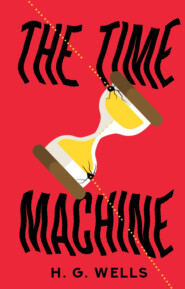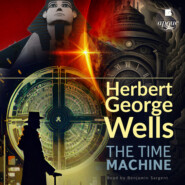По всем вопросам обращайтесь на: info@litportal.ru
(©) 2003-2025.
✖
The Time Machine
Настройки чтения
Размер шрифта
Высота строк
Поля
HarperCollins is and has always been a champion of the classics, and the current Collins Classics series follows in this tradition – publishing classical literature that is affordable and available to all. Beautifully packaged, highly collectible, and intended to be reread and enjoyed at every opportunity.
Life & Times (#ulink_70692599-99e3-5c9c-b50f-bfb28b49f168)
About the Author
When we think of H. G. Wells, we think of ground-breaking science fiction, alien life forms, prophetic man-made contraptions and intergalactic warfare. His was a mind capable not only of imagining things that were literally out of this world, but also of prophesying how mankind’s flaws might turn these apocalyptic visions into everyday reality. Most remarkable of all, it was a mind that had grown from notably ordinary beginnings.
Herbert George Wells was born in 1866 in the London suburb of Bromley, where his father, a part-time professional cricketer, owned an unsuccessful sporting-goods shop. The family struggled financially, particularly after a leg injury terminated Wells’ father’s cricketing career, and at the age of fourteen Herbert had to leave school in order to earn his keep.
For four years, Wells moved from one fruitless apprenticeship to the next, before being offered the lifeline of a return to education. He had developed a love of literature during his youth, but now, thanks to a scholarship to the Royal College of Science in London, he was able to indulge his other passion: biology. One of his teachers there was the eminent anatomist T. H. Huxley, nicknamed ‘Darwin’s Bulldog’ for his outspoken support for Charles Darwin’s controversial theory of evolution. (Perhaps coincidentally, Huxley’s grandson Aldous would also go on to become an acclaimed science-fiction writer.)
Interesting Times
Alongside Huxley’s influence, Wells developed an interest in divisive topics as a member of the student debating society. And, without doubt, he was living in interesting times. By the 1880s, the notorious rigidity of Victorian society was giving way to contentious questions about evolution, religion and equality, and Wells soon became an outspoken critic of the social status quo. He felt society could be better and stronger – essentially, more evolved. He took an early interest in the newly established Fabian Society, a socialist organisation that was subsequently instrumental in founding the British Labour Party, and which included among its members satirical dramatist G. B. Shaw and suffragette Emmeline Pankhurst.
In the early years of the twentieth century, Wells fell out very publicly with the Fabians, accusing them of being an ineffectual ‘drawing-room society’ with ‘scattered members’. He wanted them to take a more gung-ho attitude to social reform, and thereby to rally new members to the cause. They in turn were embarrassed by his unconventional private life: he was twice-married and promiscuous, and had both legitimate and illegitimate children. Wells ultimately left the group in frustration, but in the meantime his mind had been awoken to the possibility that life on earth could quite easily become either immeasurably better or immeasurably worse, visions he elaborated upon in his fictional output during these early years of his political engagement.
Scientific Romance
H. G. Wells’ first book was his 1893 Textbook of Biology, which drew on his time as a science teacher, but just two years later he produced a debut novel that made him a household name and popularised a whole new genre of fiction. The Time Machine (1895) is the story of a scientist who travels to the very distant future, where he discovers that the division between rich and poor that was entrenched in nineteenth-century society has led to mankind splitting into two distinct species. The novel was a thinly veiled warning based on Wells’ political views, but its remarkable claim to fame is that it popularised the concept of ‘time travel’ by ‘time machine’: both terms coined by Wells, and now considered staples of science fiction.
Nineteenth-century literature, propelled in part by the swift technological advances of the Industrial Revolution, had seen a gradual shift from Gothic horror – with its ghost stories and vampires – to novels that dealt with man-made futuristic inventions. Mary Shelley’s Frankenstein (1818) is now considered an early work of science fiction, but the genre came into its own in 1864 with the publication of Jules Verne’s Journey to the Centre of the Earth. Verne dominated the genre for the next two decades, but the 1890s belong firmly to H. G. Wells. Following his success with The Time Machine, Wells published, in quick succession, bestsellers including The Island of Doctor Moreau (1896), The Invisible Man (1897) and The War of the Worlds (1898). Both he and Jules Verne have subsequently been declared ‘The Father of Science Fiction’, even if, in their day, the genre was more commonly known as scientific romance.
Wells’ novels of the 1890s pushed the boundaries of scientific imagination, making fantastical notions such as genetic engineering, invisibility and extraterrestrial life forms seem alarmingly real. The War of the Worlds boasts some of the earliest fictional ‘Martians’ and describes the as-yet-uninvented laser, cornerstones too of modern science fiction. But beneath the surface, these novels continued to present nightmarish visions of a future defined by selfishness, inequality and conflict: qualities Wells hoped humankind might yet do away with.
The Time Machine
Wells’ debut novel, published in 1895, is among his more overtly political, offering a chilling vision of a future in which class-obsessed humankind has devolved into two grotesquely distinct species. This is perhaps little wonder: the story began life almost a decade earlier, around the time of Wells’ enthusiastic adoption of socialist ideas. In 1888 he had published a short story in The Science School Journal entitled ‘The Chronic Argonauts’ – this was before he hit on the term ‘Time Traveller’ – in which a professor devises a curious machine that allows him to move back and forth in time.
There is some debate as to whether Wells invented the notion of time travel by man-made contraption, but he was certainly among the very first to conceive of it. Before the 1880s, time travel tended to occur to protagonists in dreams or via some sort of supernatural visitation: Scrooge’s three ghosts in Dickens’ A Christmas Carol (1843), for instance.
When Wells returned to his work in progress, he expanded upon the professor’s findings in the future. Transported to the year 802,701, the newly named Time Traveller encounters the Eloi, who at first strike him as a simple, peaceful civilisation; one for whom intelligence is unimportant and work is non-existent. It is only when his time machine is stolen that the Time Traveller discovers the backbone of Eloi society: the subterranean Morlocks, who shun daylight and toil underground in order to keep the Eloi in the lazy comfort to which they have become accustomed. His initial appraisal that the ‘upper-class’ Eloi are being sustained by the hideous ‘working-class’ Morlocks is called into question, however, when he learns that the helpless Eloi are the Morlocks’ main source of food …
Ultimately it seems irrelevant which of the two species has the upper hand: The Time Machine is a damning premonition of a future in which the Victorian class system has run rampant at the expense of common humanity.
Paradise Lost
For all the dystopian horror of his most famous novels, Wells was, in his predictions for mankind’s future, an optimist – initially, at least. He felt at heart that humanity was on the brink of something wonderful. His 1901 work Anticipations of the Reaction of Mechanical and Scientific Progress upon Human Life and Thought set out a vision of the future in which warfare was obsolete, nations having synthesised into large peaceful blocs that treated one another with ‘intelligent sympathy’. He predicted that, by the end of the twentieth century, this social revolution would have forever assured ‘the final peace of the world’.
The First World War shook his belief, although Wells remained convinced that the reality of all-out warfare might yet sober mankind into long-term peace. In his Outline of History (1920), he defined human history as ‘more and more a race between education and catastrophe’, but predicted that progress would prevail, be it ‘clumsily or smoothly’.
By the outbreak of the Second World War – which he had predicted with eerie accuracy in his 1933 novel The Shape of Things to Come – Wells was less optimistic. It is apt that his final work, composed in 1945 and foreseeing the collapse and destruction of humanity, was entitled Mind at the End of Its Tether. He felt he had given ample warnings that had gone unheeded. Indeed, reflecting in 1941 on predictions he had made that had come horribly true, Wells suggested that his epitaph should simply read: ‘I told you so. You damned fools.’ When the end came, in 1946, his ashes were scattered at sea.
CHAPTER 1 (#ulink_2ceba050-e43c-5f0c-9f4b-a1fa5bc91829)
The Time Traveller (for so it will be convenient to speak of him) was expounding a recondite matter to us. His grey eyes shone and twinkled, and his usually pale face was flushed and animated. The fire burned brightly, and the soft radiance of the incandescent lights in the lilies of silver caught the bubbles that flashed and passed in our glasses. Our chairs, being his patents, embraced and caressed us rather than submitted to be sat upon, and there was that luxurious after-dinner atmosphere when thought roams gracefully free of the trammels of precision. And he put it to us in this way—marking the points with a lean forefinger—as we sat and lazily admired his earnestness over this new paradox (as we thought it) and his fecundity.
‘You must follow me carefully. I shall have to controvert one or two ideas that are almost universally accepted. The geometry, for instance, they taught you at school is founded on a misconception.’
‘Is not that rather a large thing to expect us to begin upon?’ said Filby, an argumentative person with red hair.
‘I do not mean to ask you to accept anything without reasonable ground for it. You will soon admit as much as I need from you. You know of course that a mathematical line, a line of thickness nil, has no real existence. They taught you that? Neither has a mathematical plane. These things are mere abstractions.’
‘That is all right,’ said the Psychologist.
‘Nor, having only length, breadth, and thickness, can a cube have a real existence.’
‘There I object,’ said Filby. ‘Of course a solid body may exist. All real things—’
‘So most people think. But wait a moment. Can an instantaneous cube exist?’
‘Don’t follow you,’ said Filby.
‘Can a cube that does not last for any time at all, have a real existence?’
Filby became pensive. ‘Clearly,’ the Time Traveller proceeded, ‘any real body must have extension in four directions: it must have Length, Breadth, Thickness, and—Duration. But through a natural infirmity of the flesh, which I will explain to you in a moment, we incline to overlook this fact. There are really four dimensions, three which we call the three planes of Space, and a fourth, Time. There is, however, a tendency to draw an unreal distinction between the former three dimensions and the latter, because it happens that our consciousness moves intermittently in one direction along the latter from the beginning to the end of our lives.’
‘That,’ said a very young man, making spasmodic efforts to relight his cigar over the lamp; ‘that … very clear indeed.’
‘Now, it is very remarkable that this is so extensively overlooked,’ continued the Time Traveller, with a slight accession of cheerfulness. ‘Really this is what is meant by the Fourth Dimension, though some people who talk about the Fourth Dimension do not know they mean it. It is only another way of looking at Time. There is no difference between Time and any of the three dimensions of Space except that our consciousness moves along it. But some foolish people have got hold of the wrong side of that idea. You have all heard what they have to say about this Fourth Dimension?’
‘I have not,’ said the Provincial Mayor.
‘It is simply this. That Space, as our mathematicians have it, is spoken of as having three dimensions, which one may call Length, Breadth, and Thickness, and is always definable by reference to three planes, each at right angles to the others. But some philosophical people have been asking why three dimensions particularly—why not another direction at right angles to the other three?—and have even tried to construct a Four-Dimension geometry. Professor Simon Newcomb was expounding this to the New York Mathematical Society only a month or so ago. You know how on a flat surface, which has only two dimensions, we can represent a figure of a three-dimensional solid, and similarly they think that by models of three dimensions they could represent one of four—if they could master the perspective of the thing. See?’
‘I think so,’ murmured the Provincial Mayor; and, knitting his brows, he lapsed into an introspective state, his lips moving as one who repeats mystic words. ‘Yes, I think I see it now,’ he said after some time, brightening in a quite transitory manner.
‘Well, I do not mind telling you I have been at work upon this geometry of Four Dimensions for some time. Some of my results are curious. For instance, here is a portrait of a man at eight years old, another at fifteen, another at seventeen, another at twenty-three, and so on. All these are evidently sections, as it were, Three-Dimensional representations of his Four-Dimensioned being, which is a fixed and unalterable thing.
‘Scientific people,’ proceeded the Time Traveller, after the pause required for the proper assimilation of this, ‘know very well that Time is only a kind of Space. Here is a popular scientific diagram, a weather record. This line I trace with my finger shows the movement of the barometer. Yesterday it was so high, yesterday night it fell, then this morning it rose again, and so gently upward to here. Surely the mercury did not trace this line in any of the dimensions of Space generally recognized? But certainly it traced such a line, and that line, therefore, we must conclude was along the Time-Dimension.’
‘But,’ said the Medical Man, staring hard at a coal in the fire, ‘if Time is really only a fourth dimension of Space, why is it, and why has it always been, regarded as something different? And why cannot we move in Time as we move about in the other dimensions of Space?’
The Time Traveller smiled. ‘Are you sure we can move freely in Space? Right and left we can go, backward and forward freely enough, and men always have done so. I admit we move freely in two dimensions. But how about up and down? Gravitation limits us there.’
‘Not exactly,’ said the Medical Man. ‘There are balloons.’
‘But before the balloons, save for spasmodic jumping and the inequalities of the surface, man had no freedom of vertical movement.’
‘Still they could move a little up and down,’ said the Medical Man.
‘Easier, far easier down than up.’
‘And you cannot move at all in Time, you cannot get away from the present moment.’
‘My dear sir, that is just where you are wrong. That is just where the whole world has gone wrong. We are always getting away from the present moment. Our mental existences, which are immaterial and have no dimensions, are passing along the Time-Dimension with a uniform velocity from the cradle to the grave. Just as we should travel down if we began our existence fifty miles above the earth’s surface.’
‘But the great difficulty is this,’ interrupted the Psychologist. ‘You can move about in all directions of Space, but you cannot move about in Time.’

















